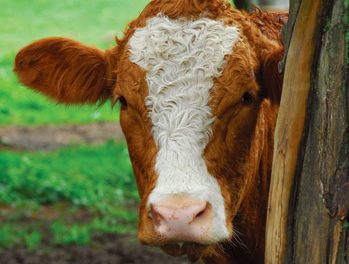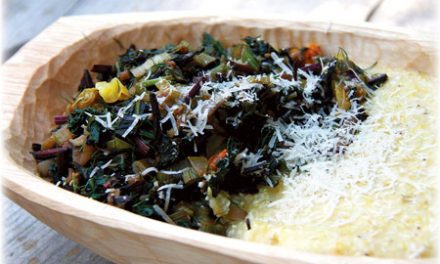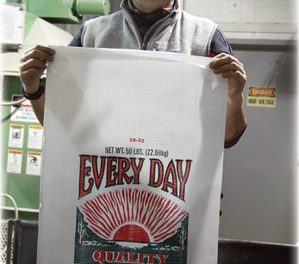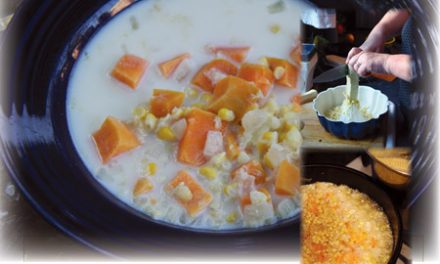
Homesteading sounds like such an old fashioned word. I always picture plaid flannel shirts and canning jars on the stove when I think of homesteading. But today, in this topsy-turvy world of electronic gadgets, indecipherable cell and cable bills, and the constant barrage of what one can or cannot eat based on the latest findings, in my home, homesteading means peace of mind.
Permaculture is a whole system design that means using as many permaculture principles in your life as possible. For me, it means little tiny changes that provide big results, give me little daily pleasures, and improve my peace of mind.
Permaculture Basics
I received my Permaculture Design Certification in the spring of 2015 which was a very stressful time for me. I had a very ill ex-husband, plus the daunting task of driving a five-hour round trip from Plymouth to Shutesbury for three three-day weekends of permaculture class, all while leaving my two semi-grown sons at home. With the encouragement of Ron Maribett, the man who first uttered the word permaculture to me, I got in my car and drove West. And boy, am I glad I did.
The three tenets of permaculture—earth care, people care, and fair share—when followed daily, present us with a set of guidelines that can change the world one yard, one project, one yield, and one person at a time.
Permaculture teaches you that everything you do, every day, has a direct result on the “big environment” and on “your environment.” You can have a large impact on your immediate world around you with tiny changes. These changes also will allow you to connect with nature, your food system, your family, and your neighbors. That’s pretty good for a tiny change!
Zoning In
Permaculture talks about zones of use, with the zones highlighting what projects go where. Based on Bill Mollison’s book Introduction to Permaculture, here are the general thoughts about the permaculture zones.
Let’s talk about Zone 0 first. It is the center of the activity and it includes us. We have to look inward before we can effect change outside of ourselves. So every day, if we get up with the mindset that we will put others first and try not to harm our environment and participate in work and activities that can help the world, we are good to go.
Zone 1 is the area that is closest to your house and that you use the most. These are the areas you would visit once a day. It would contain gardens, greenhouses, compost, and where your herb spiral will live (see sidebar). You would visit this space once a day to see how your plants are doing, water as necessary, and of course harvest something to use in the preparation of your daily meals.
Zone 2 is an area that is intensively maintained and planted with fruit trees, berry bushes, perhaps a chicken coop, and a bee hive which you would visit often.
Zone 3 is an area where there would be unpruned trees and orchards and an area for larger pastures for animals to forage.
Zone 4 is semi-managed, semi-wild, unpruned trees and forest management.
Zone 5 is an unmanaged “wild” system. This is a place to commune with nature and reflect. We are not managers but visitors here.
These zones can also overlap and interact with each other. Planning in terms of zones helps you decide where to place certain elements based on their frequency of use and scale. Most residential gardens will have mainly zones 0, 1 and 2.
PERMACULTURE…
Permaculture home gardeners work with nature rather than against nature. This approach allows a home gardener to design a garden with minimal intervention, using concepts like fruit tree guilds, food forests, and whole system design. These terms may sound unfamiliar now, but the more you learn about permaculture, the more likely that these common sense approaches will allow your home garden to thrive. As one of my permaculture presenters noted, the goal of a garden using permaculture principles is to provide you with more “hammock time.”
Permaculture allows the maximum yield with the minimal amount of work by utilizing a few concepts that allow the garden to thrive. Well prepared soil (install a compost area), ample moisture (install a rain barrel), the right choice of plants (companion planting) and proper timing (succession planting and working with nature): these concepts will allow for the maximum amount of food to be produced using minimal interventions.
Herb Spiral
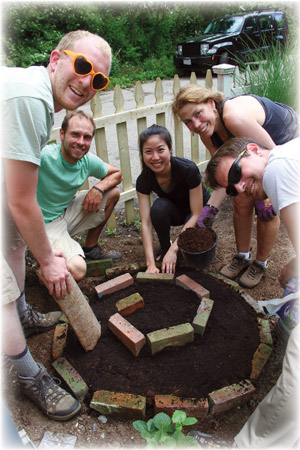
Some of the Terra Cura Inc. team working towards a regenerative culture: Dean Wile, Adam Davenport, Eva Leung, Jackie Millar, and Jason Hebert.
I do feel a bit disappointed when I purchase a bunch of herbs at the market and a few days later the bulk of the herbs have withered and are no longer usable. Perhaps you do too. The herb spiral takes care of that problem, and having one in your backyard will get much use throughout the year. I love this concept, and it is one of the many features of a permaculture landscape that can be incorporated into your living space.
The ingenious design of the herb spiral dictates that the heat-loving, arid herbs like rosemary, thyme, and oregano are placed near the top of the herb spiral and the more shade loving and water loving plants are planted around the remaining circular areas of the spiral. At the bottom of the spiral, if you want to get fancy, you can add a small pond where watercress will grow.
The materials you use to create the infrastructure of the spiral are up to you. They can be bricks that were dumped in a vacant lot or in your basement, or perhaps big rocks pulled from an area of your yard that you have been clearing for a garden. You can purchase something from a landscape supply store, but the hope is that you can re-purpose a found material to take it out of the waste stream and reuse it.
The soil should be an organic blend suitable for starting healthy plants. You can sheet mulch the area first by laying cardboard, sand, mulch, and organic materials on the surface area have a living, healthy, and happy herb spiral to visit daily and reap its yield. Function over fashion please! Remember permaculture means to mimic nature, so take a look outside and reflect on the different shapes and sizes of the trees and plants in nature.
Here is the list of plants that you can use in an herb spiral, but feel free to add others too. Oregano, thyme, lavender, and rosemary grow best near the top. In the middle, plant herbs that require moist soil conditions such as basil, sage, tarragon, lemon verbena, and cilantro. And at the bottom of the spiral plant thirstier plants like mint, parsley, and chives.
All these herbs thrive and grow throughout the spring, summer, and early fall, so your sage will be available for your turkey stuffing at Thanksgiving. The water flows from top to bottom and into the little water catchment system at the bottom, if you choose to add this feature to promote the growth of watercress. I have seen people design their herb spiral with a water feature at the top to help Mother Nature along.
You can, and should, build the spiral with friends and family. If you build it with friends get ready to reciprocate at their house. You can add plants to the spiral over the growing season or over the years. To have accessible fresh herbs, right outside your door, allows you to become a producer rather than a consumer, starting your journey down the backyard permaculture path.
Build your herb spiral this fall and be ready to plant and enjoy next spring and beyond!
Jacqueline M. Millar changed career paths after practicing law for many years. She received her Permaculture Design Certification in 2015 and is currently the Director of Education and President of Terra Cura Inc., a non-profit organization on the South Shore. www.TerraCura.org

